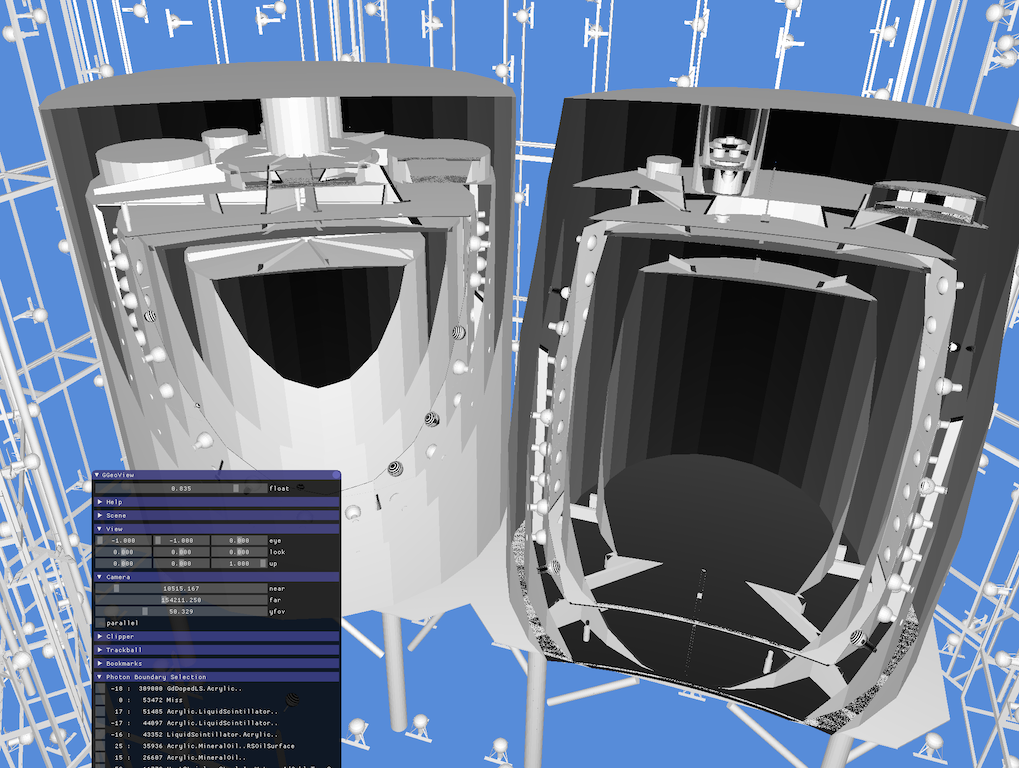Optical Photon Simulation with NVIDIA OptiX
http://simoncblyth.bitbucket.io/env/presentation/optical_photon_simulation_with_nvidia_optix.html (July 2015) http://simoncblyth.bitbucket.io/env/presentation/gpu_accelerated_geant4_simulation.html (Jan 2015)
OptiX Ray Tracing
Extreme speed ~200M ray intersections/second/GPU, regular releases, performance scales with CUDA cores across multiple GPUs.
- Why not Chroma ?
- Introducing NVIDIA OptiX
- OptiX testing
- New Packages Replacing Chroma
- Mobile GPU Timings
- Operation with JUNO Geometry ?
- Next Steps
Why not Chroma ?
Lack of multi-GPU support
Production running demands efficient use of multiple GPUs. Lack of this difficult to implement feature is a show stopper for Chroma use in production.
Chroma Features
- Python/PyCUDA/NumPy based infrastructure for geometry/photon loading, kernel launch
- accelerated geometry intersection using BVH structure
- optical photon simulation CUDA kernels
My additions to Chroma
- G4DAE Geometry import
- G4Step transport and Cerenkov/Scintillation photon generation on GPU
- OpenGL/CUDA interop visualisations
Missing Features
- GPU workload scheduling
- Multi-GPU support
https://bitbucket.org/chroma/chroma
https://bitbucket.org/simoncblyth/chroma (my fork)
Introducing NVIDIA OptiX Ray Tracing Engine [C++/C/CUDA]
OptiX Tutorial App
Image pixels calculated by recursively bouncing rays around geometry doing shadow, reflection, refraction calculations. Runs at interactive speeds with GeForce GT 750M.
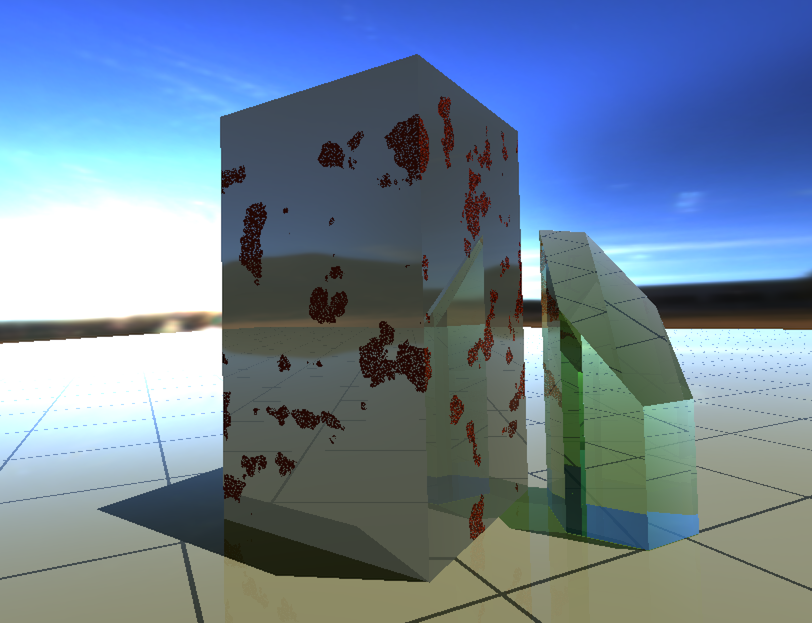
OptiX provides: CUDA compiler optimized for Ray Tracing
- ray tracing framework, no rendering assumptions
- ~200M ray/s/GPU geometry intersections
- regular releases, improvements, tuning for new GPUs
- shared C++/CUDA context eases development
NVIDIA expertise on efficient GPU/multi-GPU usage
- persistent warps sized to fill machine
- load balancing between warps, GPUs
https://developer.nvidia.com/optix
https://research.nvidia.com/publication/optix-general-purpose-ray-tracing-engine
Parallels between Realistic Image Synthesis and Optical Simulation
OptiX Glass Sample App
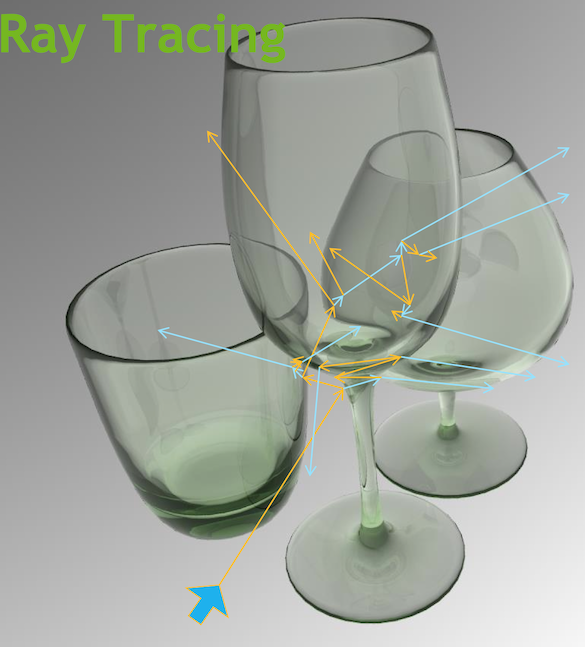
Realistic image creation uses physically based techniques and material definitions. Obvious parallels:
- ray traced rendering : image pixel calculation
- optical photon (OP) simulation : PMT hit calculation
Same rate determining step: geometry intersection
Applying techniques/hardware developed for fast ray tracing can be hugely beneficial to optical photon simulation.
- expect OP simulation performance >100x Geant4
- OP processing time becomes effectively zero
Chroma Raycast with entire geometry in view
Render Split into 3x3 CUDA kernel launches, 1 thread per pixel, ~1.8s for 1.23M pixels, 2.4M tris (with [1])
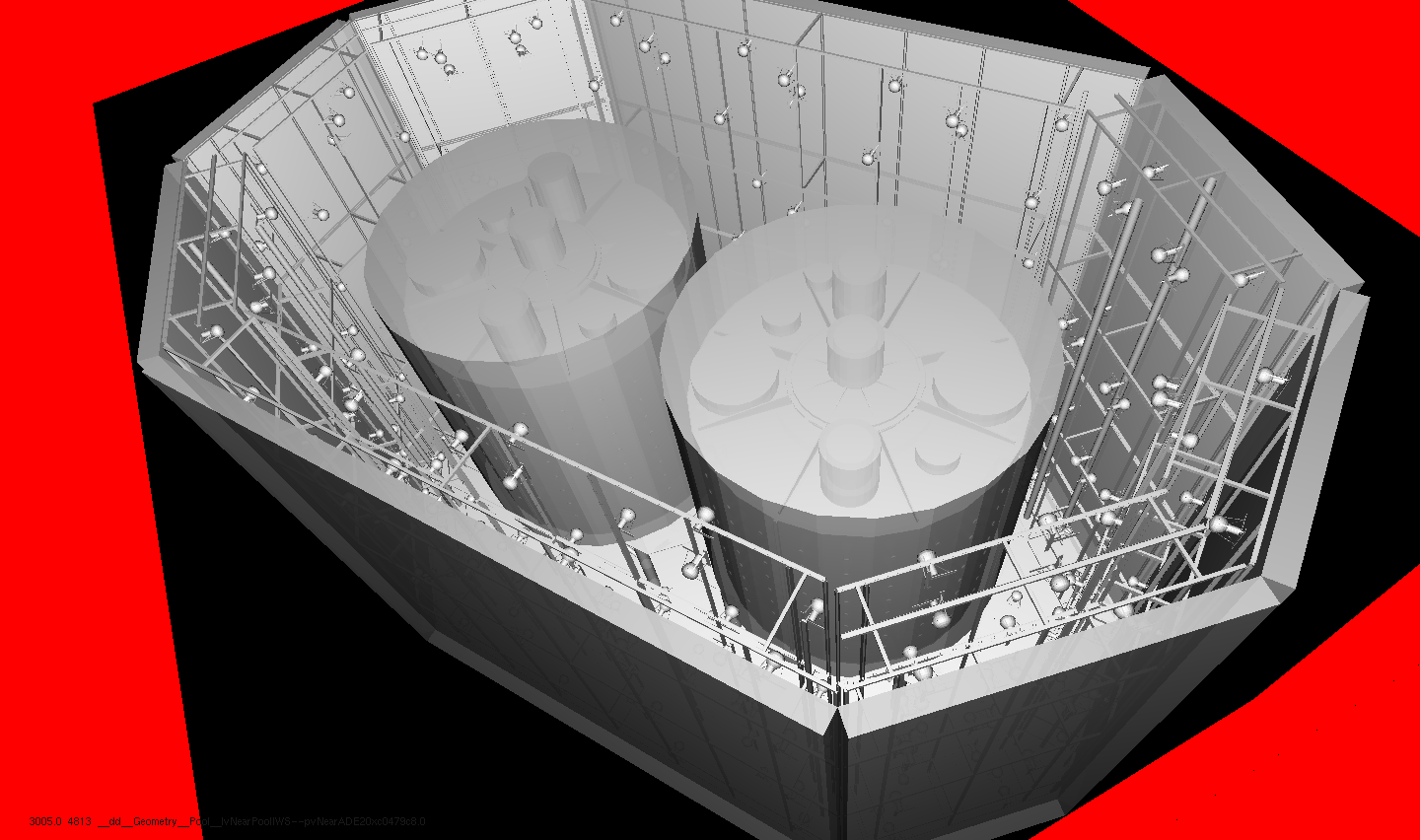
| [1] | MacBook Pro (2013), NVIDIA GeForce GT 750M 2048 MB (384 cores); Workstation GPU performance expected to scale by core count |
OptiX raycast performance
DBNS geometry raycast comparison using mobile GPU
- OptiX : interactive ~30 fps raycasting
- Chroma : 1.8s per frame
Performance improvement ~50x
OptiX Performance Scaling with GPU cores
Performance Linearity with CUDA cores
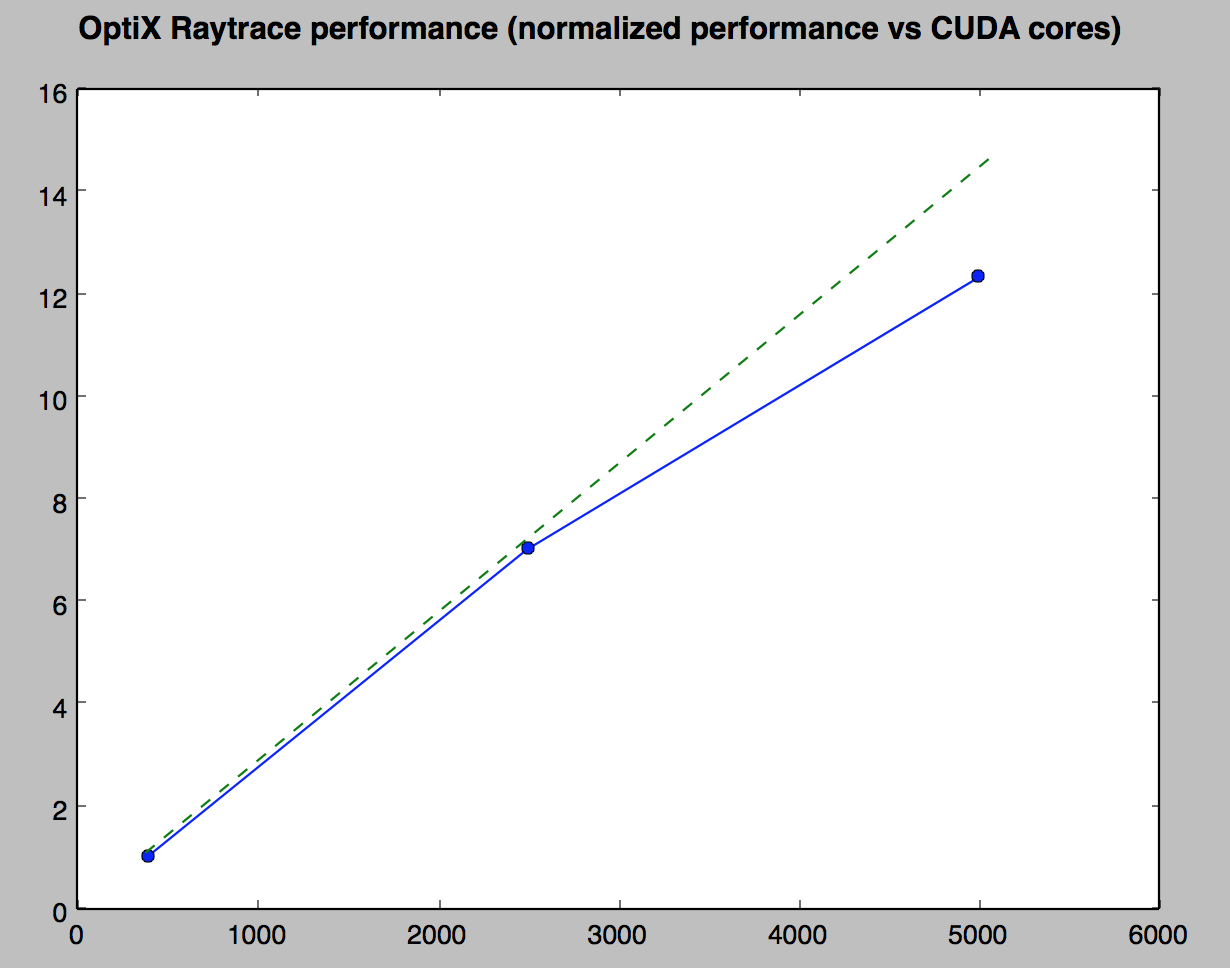
OptiX sample rendering with 2 GPU IHEP workstation,
- 2 Tesla K20m (4992 cores) 28.0 ms/f
- 1 Tesla K20m (2496 cores) 49.1 ms/f
- 1 GeForce GT 750m (384 cores) 345.1 ms/f
Performance linear with GPU cores, compared to laptop:
- 13x cores, 12x performance
Future scaling possibilities, with VCA
OptiX apps can connect to remote Visual Computing Appliances
- 1 VCA : 24,576 cores (64x laptop GPU)
Clusters of ~10 VCAs are in use by design/advertising companies for interactive product rendering.
http://www.nvidia.com/object/visual-computing-appliance.html (8 Maxwell GPUs)
OptiX Programming Model
OptiX Control Flow
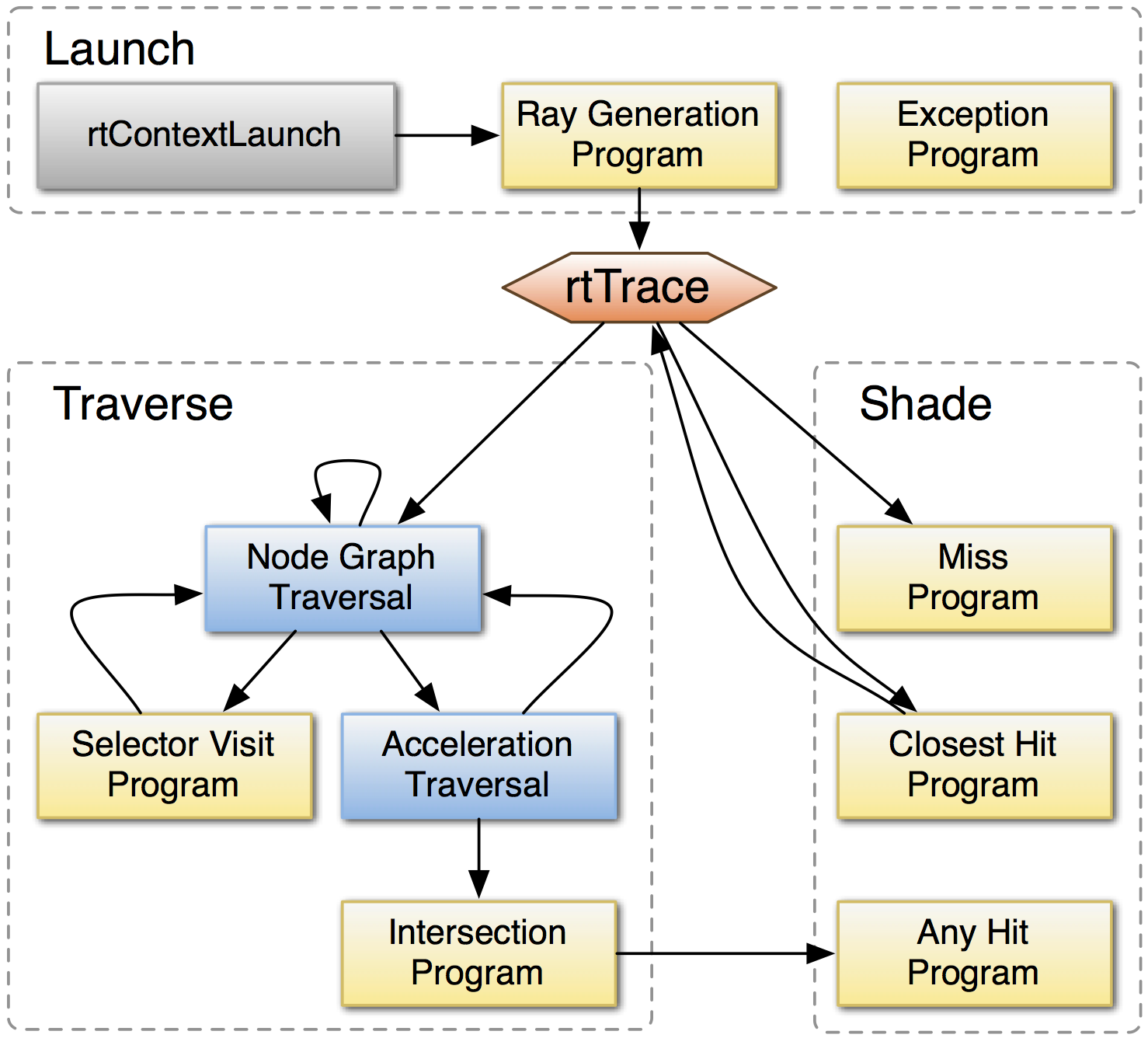
OptiX provides a ray tracing pipeline analogous to OpenGL rasterization pipeline.
- Blue: OptiX internals
- Yellow: User supplied CUDA Programs
Higher level API than pure CUDA, eg:
- shared host/device context system
Optical Photon Simulation port currently using:
- Ray Generation
- entry/exit, Cerenkov/Scintillation generation
- Intersection
- Triangle mesh intersection, boundary index lookup
- Closest Hit
- determine ray to boundary orientation
https://research.nvidia.com/sites/default/files/publications/Parker10Optix_1.pdf
OptiX Adoption Costs
Defer to NVIDIA
- acceleration structure creation and fast traversal
- efficient GPU/multi-GPU utilization
Adoption of OptiX is compelling
- extremely fast intersection performance
- scales with CUDA cores across multiple GPUs
- improves with each release
- releases tune for new GPU architectures
Costs of adoption
- learn new tools: OptiX, Thrust
- develop C++ replacement for Chroma/G4DAE python
- port Chroma/G4 optical physics into new framework
- validate against Geant4
- develop memory efficient geometry representation
New C++ Packages Replacing Chroma
~10 Packages Developed
Organized by dependencies
- Recreates Geant4 context on GPU
- Optical simulation by OptiX programs
- Visualization by OpenGL GLSL Shaders
Interop between OpenGL/OptiX/Thrust/CUDA
- shared GPU buffers, efficient visualization
Externals:
- Boost libraries
- Boost-Asio, Asio-ZMQ, ZMQ
- CUDA 7.0, Thrust 1.8
- OptiX 3.8
- OpenGL 4.1 (GLEW, GLFW, GLM)
- ImGUI
See backup for details, source links
Basis packages
- NPY : host array handling, persistency
- NumpyServer : network IO of NPY arrays
- BCfg BRegex : configuration
Geometry packages
- GGeo : preparing geometry for GPU
- AssimpWrap : G4DAE geometry loading using forked Assimp
GPU library interface packages
- CUDAWrap : pseudo random numbers with cuRAND
- OptiXRap : geometry loading, OptiX launch control
- OGLWrap : OpenGL visualization
- ThrustRap : photon indexing, using CUDA Thrust
Main package
- GGeoView : optical physics OptiX programs, OpenGL shaders
https://bitbucket.org/simoncblyth/env/src/tip/graphics/ggeoview/
Selection of GPU development details
Some details of GPU developments described over the next pages
Optical Physics
- Porting Optical Physics from Geant4/Chroma into OptiX
- Optical Physics Implementation
Supplying the OptiX Programs
- Random Number Generation in OptiX programs
- Fast material/surface property lookup from boundary texture
- Reemission wavelength lookup from Inverted CDF texture
Handling Outputs
- Recording the steps of millions photons
- Indexing photon flag/material sequences
- Introducing CUDA Thrust
Porting Optical Physics from Geant4/Chroma into OptiX
Synthesis of sources
- Chroma: overall propagation loop structure
- Geant4: simulation details
- Graphics: fast computation techniques
rtTrace OptiX fast geometry intersection
- propagate_to_boundary
- ~G4OpAbsorption, ~G4OpRayleigh
- propagate_at_surface/propagate_at_boundary
- ~G4OpBoundaryProcess
Photon p ; State s ; PerRayData prd ;
while(bounce < bounce_max) // PSEUDO-CODE
{
bounce++
ray = optix::make_Ray(p.pos, p.dir,...)
rtTrace(geom, ray, prd)
if(!prd.boundary) break // MISS
cmd = propagate_to_boundary(p, s)
if(cmd == BREAK) break // ABSORB
if(cmd == CONTINUE) continue // REEMIT, SCATTER
// survivors pass to boundary
if(s.surface_index)
{
cmd = propagate_at_surface(p, s, g)
if(cmd == BREAK) break // SURFACE_ABSORB, SURFACE_DETECT
if(cmd == CONTINUE) continue // REFLECT_DIFFUSE, REFLECT_SPECULAR
}
else
{
propagate_at_boundary(p, s) // BOUNDARY_REFLECT BOUNDARY_TRANSMIT
}
}
https://bitbucket.org/simoncblyth/env/src/tip/graphics/ggeoview/cu/generate.cu
Optical Physics Implementation
Approach
- Overall Structure from Chroma
- Aiming for equivalence with Geant4
- Optical Surface treatment in progress
Texture lookups of material/surface properties and reemission wavelengths keeps kernels simple
- Rayleigh Scattering
- Direct port of G4OpRayleigh (Xin Qian patch)
- Reemission
- Treated as subset of absorption, conferring rebirth
- wavelength from reemission texture lookup
- Boundary Reflect/Transmit
- Snell's law rearranged to avoid transcendentals
- Russian Roulette treatment of S or P polarization (simpler than G4)
- propagate_at_surface: Absorb, Detect, Reflect Diffuse/Specular
- surface properties still being debugged
- G4 Unified model (SPECULARLOBE/SPIKE etc..) not yet ported
https://bitbucket.org/simoncblyth/env/src/tip/graphics/ggeoview/cu/rayleigh.h
https://bitbucket.org/simoncblyth/env/src/tip/graphics/ggeoview/cu/propagate.h
Random Number Generation in OptiX programs
cuRAND library from CUDA toolkit features:
- concurrent generation of reproducible pseudorandom number sequences
- sub-sequences are assigned to each CUDA thread, which maintains position in sub-sequence
- per-thread state is initialized within CUDA kernel
cuRAND Initialization demands large stack size
Stack sizes 10x typical for OptiX programs were needed, resulting in slow OptiX running.
Workaround:
- use separate pure CUDA launches to initialize cuRAND
- copy curandState back to host and persist to file
- prior to OptiX launch, copy persisted curandState to GPU
- OptiX can then use cuRAND without having to initialize it
Packaged solution into CUDAWrap
Fast material/surface property lookup from boundary texture
Fast GPU texture lookup
GPUs contain hardware dedicated to fast texture lookup and interpolation. Using texture lookup for all properties and reemission wavelengths keeps OptiX programs simple.
AssimpWrap creates GGeo boundary instances and labels triangles with boundary indices, boundaries contain:
- inner material : self
- outer material : parent
- inner surface : outwards going photons (self to parent)
- outer surface : inwards going photons (parent to self)
Properties are interpolated onto a common wavelength domain
- material : refractive_index, absorption_length, scattering_length, reemission_prob (float4)
- surface : detect, absorb, reflect_specular, reflect_diffuse (float4)
Interleaved properties used to create single boundary texture 2d (wavelength, qty line) containing ~50 boundaries, 4 float4 each. CUDA tex2d property lookup:
float nmi = (nm - wavelength_domain.x)/wavelength_domain.z + 0.5f ; float4 material1 = tex2D(wavelength_texture, nmi, line + 0.5f ); float refractive_index = material1.x ; float absorption_length = material1.y ; float scattering_length = material1.z ;
https://github.com/simoncblyth/assimp (my fork of Assimp)
Reemission wavelength lookup from Inverted CDF texture
Inverting Reemission CDF allows using texture lookup to obtain reemission wavelength from uniform random throws. Using 4096 probability bins.
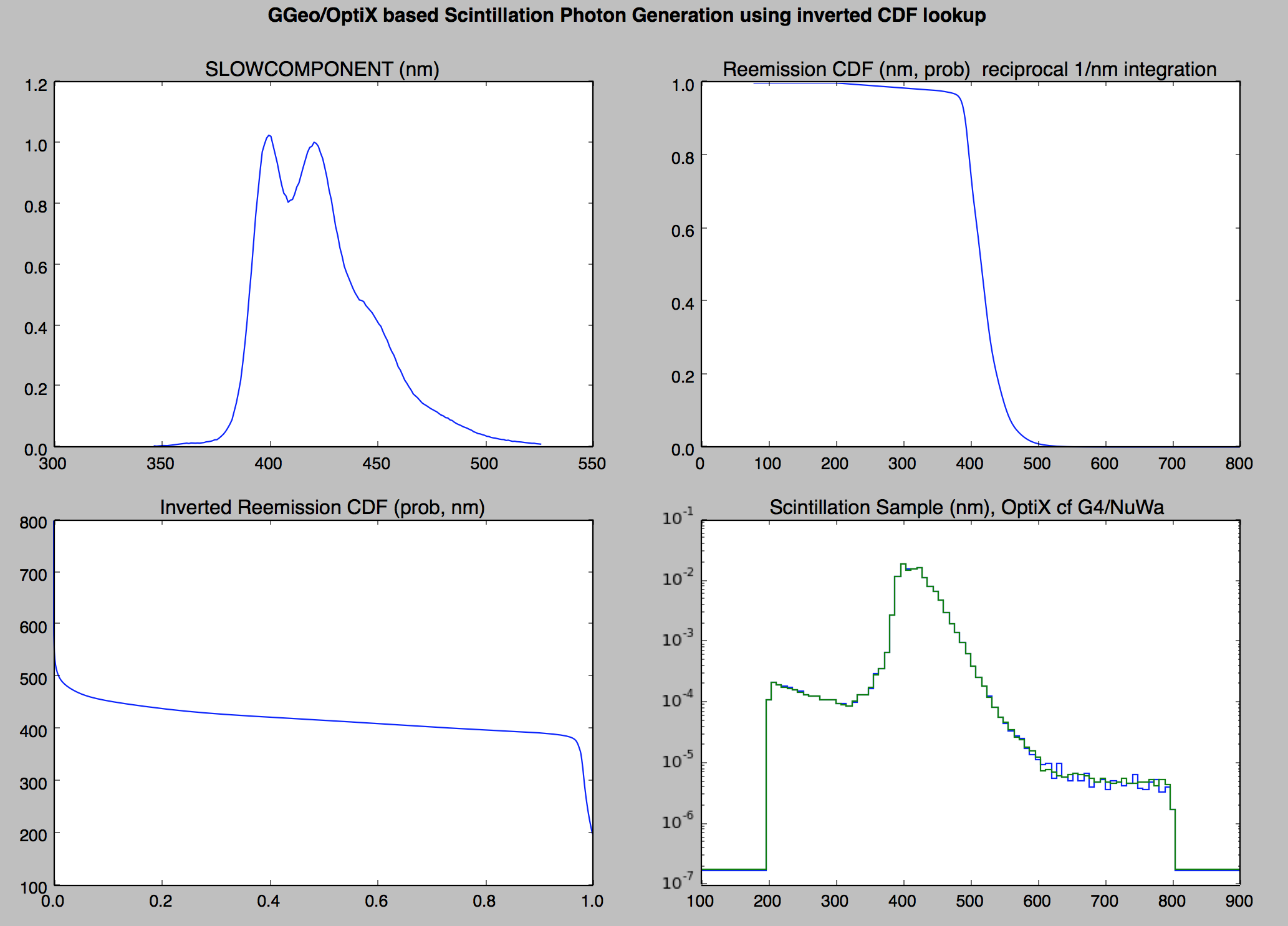
Recording the steps of ~3 million photons
128 bit compressed record
Compression necessary to work with ~30M records (30M * 128bit = ~500 MB)
GPU memory 2 GB
Up to 10 steps of the photon propagation are recorded.
Photon buffer : 4 * float4 = 512 bits/photon
- float4: position, time [32 * 4 = 128 bits]
- float4: direction, weight
- float4: polarization, wavelength
- float4: flags: material, boundary, history
Record buffer : 2 * short4 = 2*16*4 = 128 bits/record
- short4: position, time (snorm compressed) [4*16 = 64 bits]
- uchar4: polarization, wavelength (uchar compressed) [4*8 = 32 bits]
- uchar4: material, history flags [4*8 = 32 bits]
Compression uses known domains of position (geometry center, extent), time (0:200ns), wavelength, polarization.
Union trickery allows recording ints into floats
GGeoView M1 Points
Scintillation Photons colored by material
Visualization of 30M scintillation photon records from an 100 GeV muon crossing Dayabay AD. Primaries are simulated by Geant4, Scintillation "steps" of the primaries are transferred to the GPU, where photons are generated, propagated using NVIDIA OptiX and visualized using OpenGL. The dots represent propagation step positions with colors corresponding to materials.
Indexing photon flag/material sequences

Selecting photons by flag/material sequences, requires indexing integer sequences.
- CK : Cerenkov
- BT : Boundary Transmit
- BR : Boundary Reflect
- RE : Reemission
- AB : Absorb
- BS : Bulk Scatter
Indexing history/material sequences for 3M photons:
- CPU STL map, sstream ~40s
- CUDA Thrust sorted sparse histogram <0.4s
Packaged indexing into ThrustRap ThrustIdx
GGeoView Flag Selection
Selection by flag sequence
Selection of scintillation photons by flag sequence (all boundary transmit) from a 100 GeV muon crossing Dayabay AD. Primaries are simulated by Geant4, Scintillation "steps" of the primaries are transferred to the GPU. The dots represent OptiX calculated photon steps with colors corresponding to materials.
Introducing CUDA Thrust

Distributed with CUDA
- C++ template library for CUDA based on STL
- higher level way to use CUDA
- https://developer.nvidia.com/Thrust
GPU performance without developing CUDA kernels
Mobile GPU Timings for Cerenkov and Scintillation photons
Avoid CPU for performance
- allocation of ~700MB host memory dominates
- workstation GPU core counts => generatePropagate will become effectively zero
Once debugged can skip:
- recording photon steps, indexing, OpenGL visualization
- most host allocations
Possible approach:
- allocate GPU only photon buffers using Thrust
- Thrust interop with OptiX to populate buffers
- copy back just the hits using thrust::copy_if
max_record:10
max_bounce:9
Cerenkov Ck*4.59 Scintillation
photons 0.61M 2.8M 2.8M
--(bytes)--------------------------------------
genstep size 736K 1.3M
photons size 37M 172M
records size 97M 430M
--(seconds)------------------------------------
createOpenGLCtx 0.692 - 0.599
loadGeometry 1.570 - 1.302
interpGeometry 0.211 - 0.190
initOptiX 4.216 - 6.521
loadGenstep 0.011 - 0.014
hostEvtAllocation ** 3.540 16.275 16.179
uploadEvt 0.232 1.066 0.552
generatePropagate ++ 1.404 6.453 7.907
evtDownload ** 0.348 1.602 1.780
evtSave ** 0.437 2.008 2.006
sequenceIndex 0.134 0.614 0.359
-----------------------------------------------
** scales by photon count
Operation with JUNO Geometry ?
OptiX Julia Set Sample
Ray tracing with purely analytic geometry, ie no triangles. Application to PMTs may allow drastic reduction in memory usage and access costs.

The large number of PMTs may require a more memory efficient geometry representation using OptiX features:
- parameterized geometry avoids tesselation, like Geant4
- geometry instancing avoids duplication
Memory access (not calculation) typically limits GPU performance, improving memory efficiency expected to improve performance.
Next Steps
Test New Framework with IHEP 4-GPU workstation (together with Tao Lin)
- check performance scaling across 4-GPU cores
- attempt loading JUNO geometry
- investigate more memory efficient geometry techniques
Optical Photon Simulation
- Complete porting Optical Physics
- Instrument Geant4 optical photon propagation, by recording photon steps into NPY array to enable step-by-step comparison
- Debugging to achieve match between Geant4 and GPU optical photon simulation,
- QE details to port
G4DAE Geometry Exporter
- investigate issue inherited from GDML of a skipped edge case (when a volume is shared between multiple volume pairs) resulting in missing G4LogicalBorderSurface
- incorporate into Geant4 codebase
"Backup" : Details for Reference
On the following pages:
- GGeo/OptiX Generated Scintillation Photons cf Geant4
- GGeo/OptiX Generated Cerenkov Photons cf Geant4
- Cerenkov Photon Steps
- C++ Infrastructure : foundation packages
- C++ Infrastructure : domain packages
- propagate_to_boundary : ABSORB(REEMIT) / SCATTER / survive
- Comparison of GGeo/OptiX Generated Scintillation Photon Distributions
- Comparison of GGeo/OptiX Generated Cerenkov Photon Distributions
GGeo/OptiX Generated Scintillation Photons cf Geant4
GGeo/OptiX using inverted CDF reemission wavelength lookups (4096 bins)
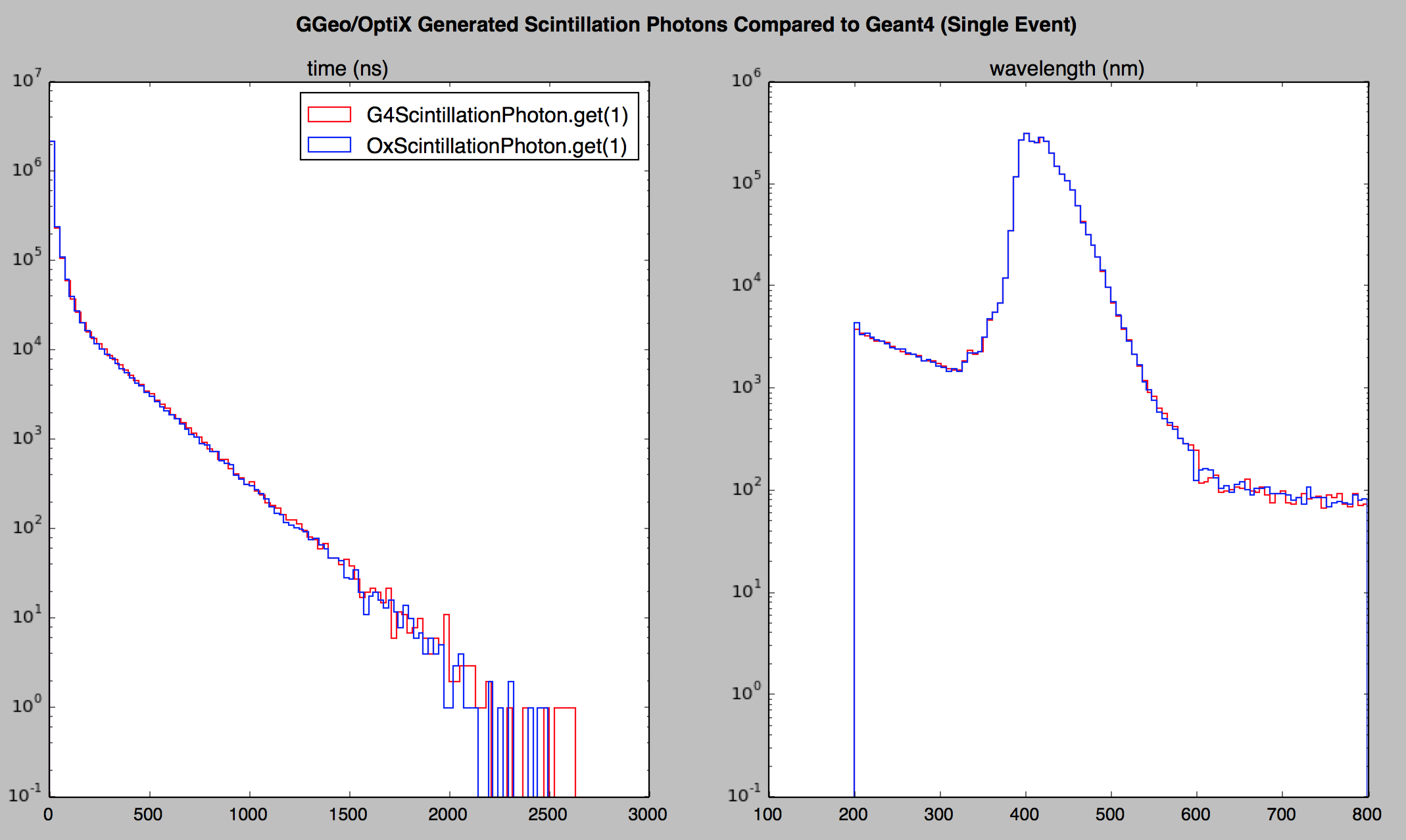
GGeo/OptiX Generated Cerenkov Photons cf Geant4
Geant4/DetSim wavelength distribution has a blip at 200nm, corresponding to edge of water refractive index properties.
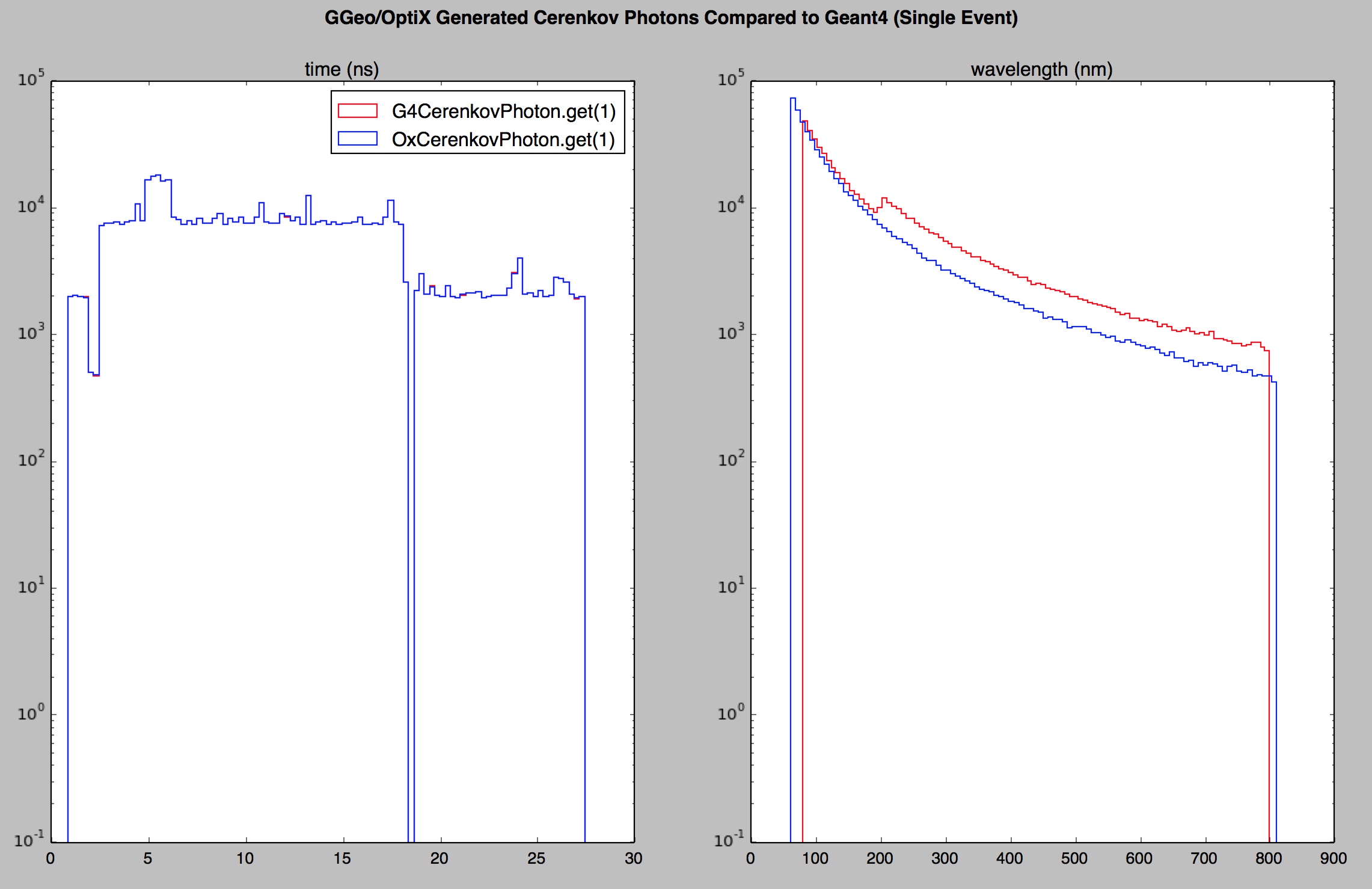
GGeoView Cerenkov Geom M1
Cerenkov Photon Steps
Cerenkov photons steps from a 100 GeV muon crossing Dayabay AD. Primaries are simulated by Geant4, Cerenkov "steps" of the primaries are transferred to the GPU. The dots represent OptiX calculated photon steps with colors corresponding to materials.
C++ Infrastructure : foundation packages
Replacing Python, NumPy, PyZMQ
Boost Libraries (filesystem, thread, program_options, logging, regex, ptree, Asio) and Asio-ZMQ, ZMQ used to replace python packages.
NPY format convenient for C++/Python interop:
a = np.load("photons.npy")
- NPY
Array persistency/manipulations inspired by NumPy, using NPY serialization format
- 11 classes: G4StepNPY, PhotonsNPY, NPY, ...
- NumpyServer
Asynchronous IO of Geant4 Steps, Photons, Hits. Communicates with remote G4DAEOpticks process, receiving steps and replying with hits.
- 7 classes : numpydelegate, udp_server, ...
- CUDAWrap
cuRAND init and persist curandState (pure CUDA)
- avoids large stack size requirement of cuRAND init within OptiX
- 5 classes : cuRANDWrapper, LaunchSequence, LaunchCommon, ..
https://bitbucket.org/simoncblyth/env/src/tip/numerics/npy/
https://bitbucket.org/simoncblyth/env/src/tip/boost/basio/numpyserver/
https://bitbucket.org/simoncblyth/env/src/tip/cuda/cudawrap/
C++ Infrastructure : domain packages
Replacing Python packages
Many C++ classes required to replace:
- PyCOLLADA
- PyOpenGL + glumpy + GLUT
- daenode.py
- g4daeview.py
Migration allows use of modern OpenGL 4.1:
- better visualization performance
- retina resolution support
- many GUI packages to choose from, picked https://github.com/ocornut/imgui
- GGeo
GPU Geometry representation, NPY persistency
- 22 classes: GNode, GMaterial, GProperty, ...
- AssimpWrap
G4DAE -> GGeo geometry
- 7 classes : AssimpGGeo, AssimpTree, ...
- OptiXRap
GGeo -> OptiX geometry, OptiX launch control
- 7 classes : OptiXEngine, OptixGeometry, ...
- OGLRap
OpenGL shader based 3D visualization
- 29 classes : Scene, View, Camera, Rdr, Shdr, ...
https://bitbucket.org/simoncblyth/env/src/tip/optix/ggeo/
https://bitbucket.org/simoncblyth/env/src/tip/graphics/assimpwrap/
https://bitbucket.org/simoncblyth/env/src/tip/graphics/oglrap/
https://bitbucket.org/simoncblyth/env/src/tip/graphics/optixrap/
propagate_to_boundary : ABSORB(REEMIT) / SCATTER / survive
__device__ int propagate_to_boundary( Photon& p, State& s, curandState &rng)
{
float absorption_distance = -s.material1.y*logf(curand_uniform(&rng)); // .y:absorption_length
float scattering_distance = -s.material1.z*logf(curand_uniform(&rng)); // .z:scattering_length
if (absorption_distance <= scattering_distance)
{
if (absorption_distance <= s.distance_to_boundary)
{
p.time += absorption_distance/(SPEED_OF_LIGHT/s.material1.x); // .x:refractive_index
p.position += absorption_distance*p.direction;
if (curand_uniform(&rng) < s.material1.w) // .w:reemission_prob
{
// non-scintillators have zero reemission_prob
p.wavelength = reemission_lookup(curand_uniform(&rng));
p.direction = uniform_sphere(&rng);
p.polarization = normalize(cross(uniform_sphere(&rng), p.direction));
s.flag = BULK_REEMIT ;
return CONTINUE;
}
else
{
s.flag = BULK_ABSORB ;
return BREAK;
}
}
// otherwise sail to boundary
}
else
// scattering ..
Comparison of GGeo/OptiX Generated Scintillation Photon Distributions
Position, direction, polarization XYZ + time, wavelength, weight
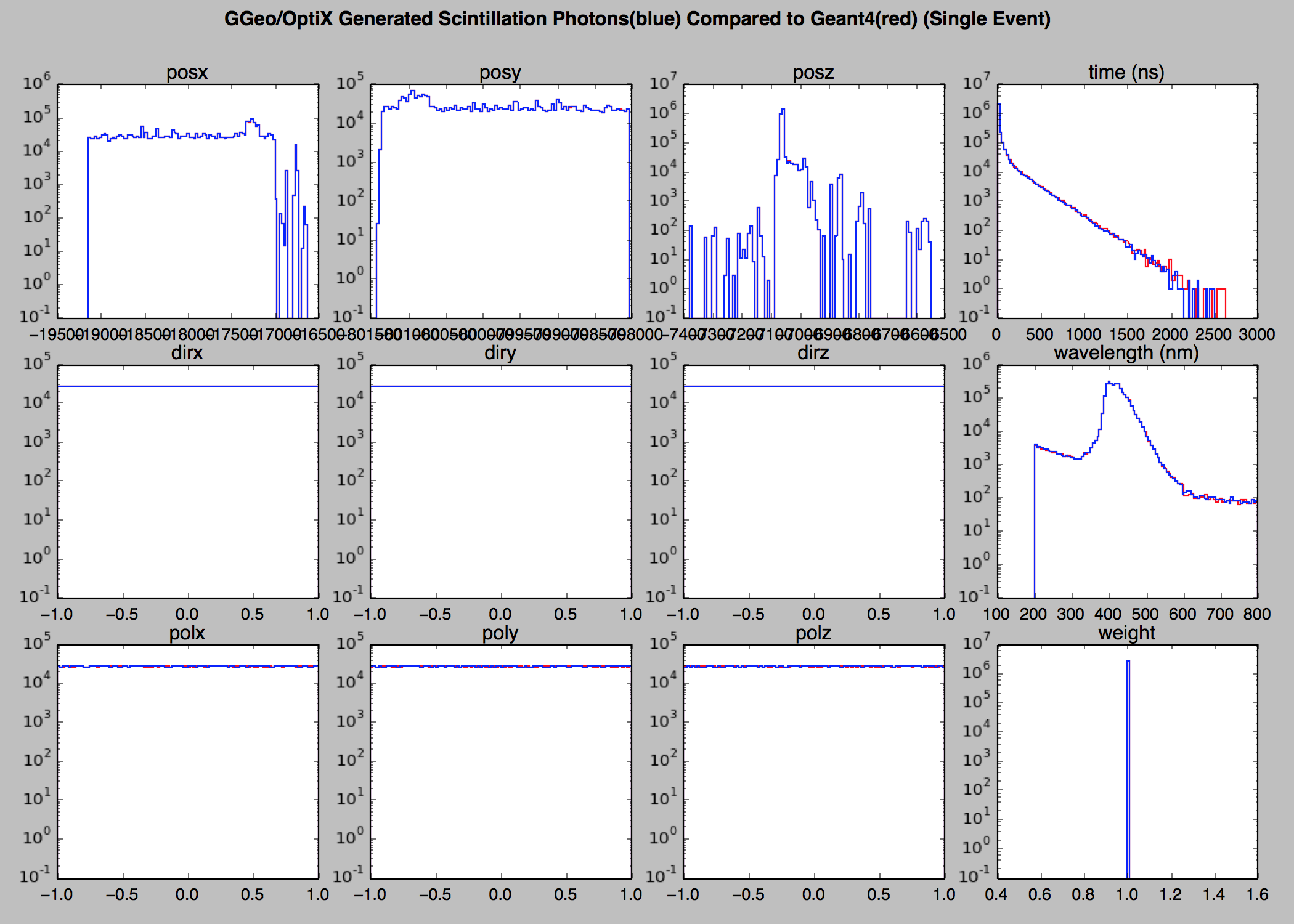
Comparison of GGeo/OptiX Generated Cerenkov Photon Distributions
Position, direction, polarization XYZ + time, wavelength, weight
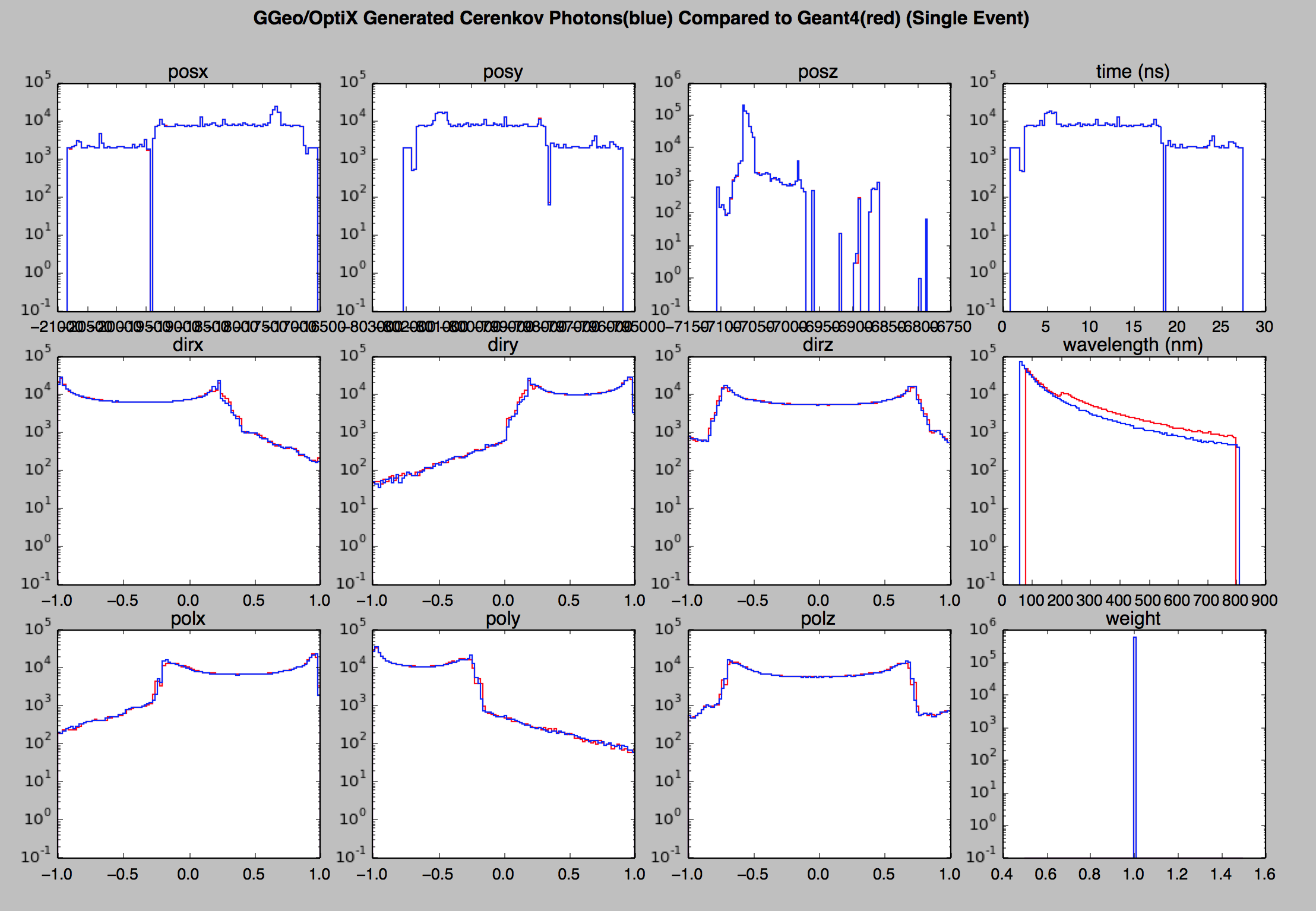
GGeoView
GGeoView
Cerenkov photons from an 100 GeV muon travelling from right to left across Dayabay AD. Primaries are simulated by Geant4, Cerenkov "steps" of the primaries are transferred to the GPU. The dots represent OptiX calculated first intersections of GPU generated photons with colors corresponding to material boundaries: (red) GdDopedLS:Acrylic, (green) LiquidScintillator:Acrylic, (blue) Acrylic:LiquidScintillator, (white) IwsWater:UnstStainlessSteel, (grey) others. The red lines represent the positions and directions of the "steps" with an arbitrary scaling for visibility.
